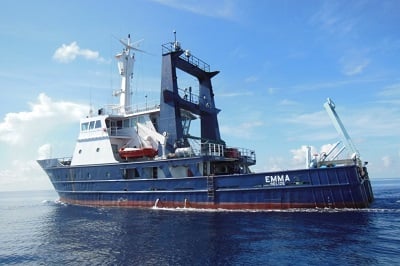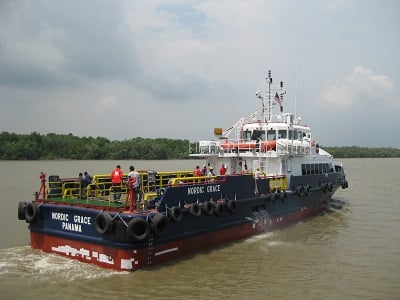New Chase Vessel Designed for Seismic Nodes
Seismic and offshore services provider Nordic Maritime is celebrating 15 years of operation with the construction of a specialist chase vessel specifically designed to support the latest seismic technology.
Cat 28 will be able to support 4D Ocean Bottom Node (OBN) surveying and, as such, can be offered as a chase vessel for deployment and recovering of the underwater nodes used in that type of surveying. It will also be able to function as a crew transfer, medevac vessel or a geophysical survey ship offering mapping, side scan sonar and core sampling capability.
.jpg) “OBN is the way forward for seismic surveys, at least for the foreseeable future,” says Kjell Gauksheim, Nordic Maritime CEO. “Nodes are able to penetrate and record data in more areas, and more effectively, than ocean bottom cable (OBC) technology allows.
“OBN is the way forward for seismic surveys, at least for the foreseeable future,” says Kjell Gauksheim, Nordic Maritime CEO. “Nodes are able to penetrate and record data in more areas, and more effectively, than ocean bottom cable (OBC) technology allows.
“Ocean Bottom Node is best described as standalone seabed recording and data storage unit technology. It is applied science that makes 4D seismic surveys possible. At Nordic Maritime, we are actively developing the new system to be combined with conventional 2D and 3D marine acquisition technology in order to create a genuinely comprehensive survey package.”
Modern technology allows nodes to record four-component (4C) data for periods of 25 days or even slightly more. The nodes record hydrophone and share wave data in 4C mode. Hydrophone data in 3 axis, XYZ, and share wave is by Geophone. The primary use of 4C nodes is for better structural imaging with multi-azimuth and for use in obstructed areas where conventional techniques, with towed streamer and OBC applications, are neither practical nor very safe. Nodes are connected in a series or deployed individually, depending on the layout of the survey area.
Once deployed, the nodes themselves store data internally, eliminating the need for cables and their associated limitations, troubles and hold-ups, says Gauksheim. Being cable-free, nodes provide a very low-impact alternative in environmentally sensitive areas. Their deployment and retrieval is also far more efficient and faster than with OBC. Built-in acoustic transponders enable their accurate positioning and tracking and, being extremely mobile, sturdy in construction, and able to record constantly, nodes can move into ocean floor areas where OBCs are not able to delve, capturing at least 98 percent of all available data.
As well as its technical flexibility, the new 28m vessel features a lightweight aluminium hull, ensuring less than a tonne of fuel consumption per day. “This fuel saving is hugely significant, representing only a fifth of what other modern chase boats use today,” he says.
The new vessel will build by Marine Diesel Services and is based on the expertise and experience Incat Crowther has demonstrated by vessels such as Unlimited, Limitless, Straight Shooter and Vejunas, resulting in one of the most capable and versatile vessel of its type and size, says Incat.
The aft deck of the vessel measures 70sqm, with a 3t/m2 deck rating. It will be fitted out with pad eyes for towing, a 3-tonne A-Frame, an integrated winch base and a deck crane. There will also be multiple lashing points for tying down containers and other freight.
Dedicated to personnel in transit, the aft portion of the main deck cabin features a four-person cabin, changing room, bathroom, showers, medevac, seats for 42 and ample luggage racks. Personnel accommodation continues in the starboard hull with a four-person cabin and a two-person cabin, both with en-suites. The forward end of the main deck cabin features a crew galley and mess, as well as access to the port hull, which accommodates six crew in an arrangement that mirrors the personnel accommodation in the starboard hull. The hulls also house a cool room, a pantry and a laundry, further enhancing the vessel’s long-range credentials.
The vessel will be powered by a pair of Caterpillar C18 main engines, each producing 533kW. The vessel’s service speed will be 12 knots, with a top speed of 16 knots. The vessel will be classed by ABS and is due to be delivered in the fourth quarter of 2014.
As well as headquarters in Singapore, Nordic has offices in Jakarta specialising in the operation and management of Indonesian flagged vessels, and this is where CAT 28 is destined. “The vessel will be Indonesian flagged to comply with local cabotage law, meaning it can freely operate in those waters and cater for the burgeoning Indonesian market, on which global exploration and production interest is keenly focused. That said, the vessel will be high-seas compliant, feature considerable long-range fixtures, and could therefore sail in anywhere worldwide to engage its services,” says Gauksheim.

“In 2005 we became an owner/manager with the acquisition of our very first seismic survey/utility vessel: the MV Emma. Then in 2006 we brokered a shipbuilding transaction between Tebma Shipyard (India) and two Norwegian shipowners, Active Subsea and DOF, valued at approximately US$350 million. Correspondingly, we secured a contract for the project management and building supervision of eight new MPSV offshore vessels.”
In 2007, Nordic was the first marine seismic company to collaborate with the Vietnamese National Oil Company (PVEP). The company started a project which included the conversion and operation of a 2D seismic vessel. “We were also asked to include a nationalisation plan to train all local engineers via a bespoke “on the job” course. The project was successfully completed in December 2010.
 “In 2010 we also moved in the crew boat sector with the launch of the Nordic Grace. Since last year, we have operated a seismic research vessel capable of 3D surveys in Indonesian waters, fully complying with Indonesian cabotage law. Nowadays we operate worldwide, providing offshore services ranging from 2D and 3D marine seismic acquisition to deep offshore accommodation, construction and supply.”
“In 2010 we also moved in the crew boat sector with the launch of the Nordic Grace. Since last year, we have operated a seismic research vessel capable of 3D surveys in Indonesian waters, fully complying with Indonesian cabotage law. Nowadays we operate worldwide, providing offshore services ranging from 2D and 3D marine seismic acquisition to deep offshore accommodation, construction and supply.”
The company is expanding and has four new vessels under construction, with deliveries expected between the end of this second quarter of 2014 and the second quarter of 2016. One of its newest DP2 vessels, Mokul Nordic, has recently commenced an IMR contact with N-Sea Offshore in the North Sea. "Mokul Nordic is a DP2 VS470 MKIII subsea service vessel capable of ROV operations as well as deep water module handling,” said Gauksheim. A sister vessel is currently under construction and will be delivered in 2015.
